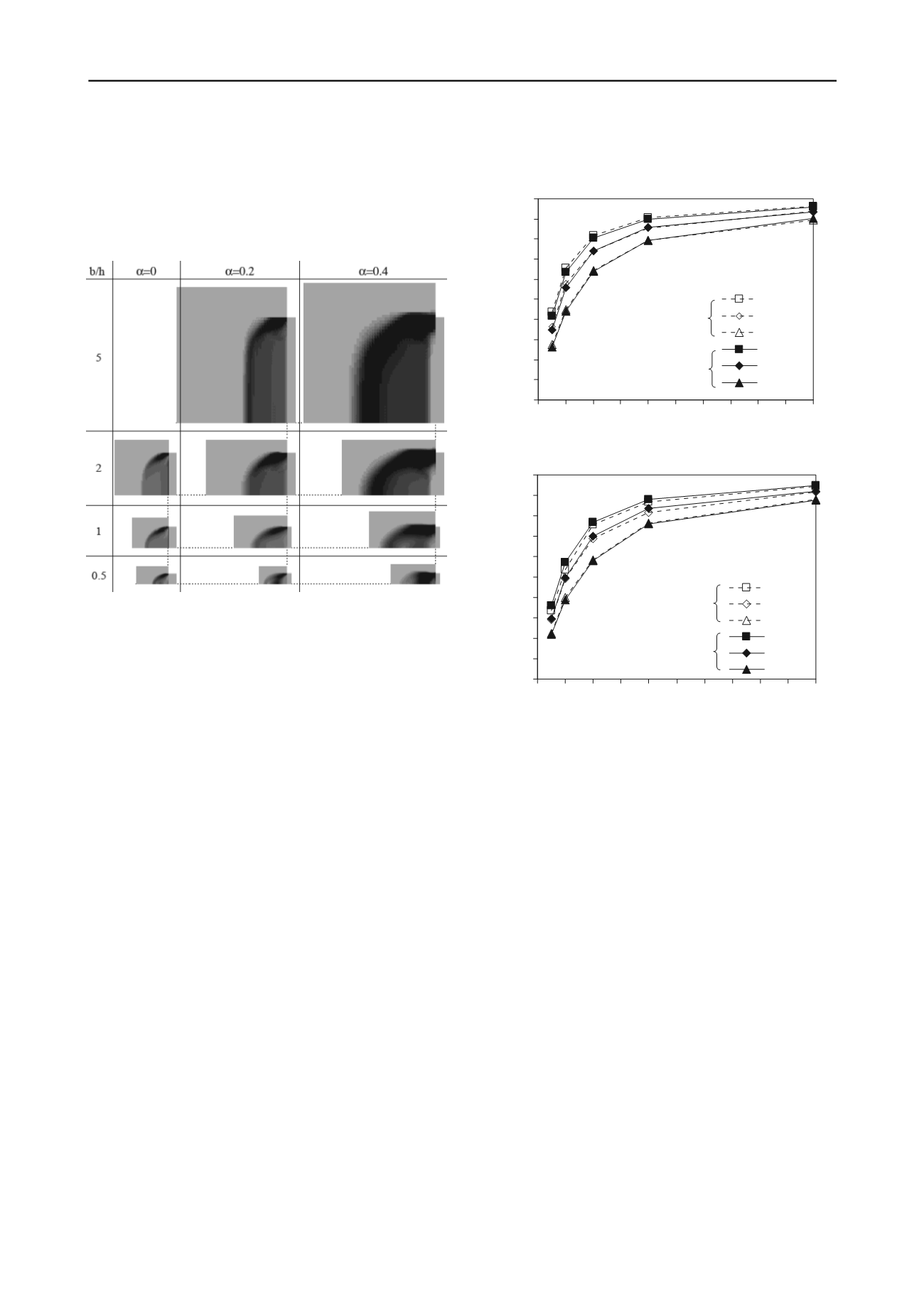
1582
Proceedings of the 18
th
International Conference on Soil Mechanics and Geotechnical Engineering, Paris 2013
b/h ratio on the mechanism involved in the active condition of
the soil behind the wall. It can be seen that there is a very clear
influence of that ratio on the size of the mechanism and,
particularly, on the extension of soil involved in the mechanism,
behind the wall, for b/h<2. It can also be seen that the
mechanisms show a greater three-dimensional effect for the
greater values of
.
Figure 6. Plan view of the plastic deformation zones for
’=30º,
’=2/3, several b/h ratios – 0.5, 1, 2 and 5 -.and three values of
– 0,
0.2 and 0.4.
Figure 7 represents the values of the ratio K
as
h
/K
as
h2D
as a
function of b/h, for all cases analyzed. It can be observed, as
expected, that this ratio increases with b/h. It can also be
observed that the ratios are greater for
’=30º than for
’=40º
and greater for the smaller values of
. But, particularly, it can
be seen that the ratios of the active earth pressure coefficients
are practically independent on the soil-to-wall friction ratio. In
fact, the results for
’=0 are superposed with the ones for
’=2/3. This independence on the soil-to-wall friction ratio
was also detected in the determination of static passive earth
pressure coefficients (Antão et al. 2011).
CONCLUSIONS
A three-dimensional numerical implementation of the limit
analysis upper bound theorem, the finite element program
Sublim3D, was used to determine seismic active horizontal
earth pressure coefficients. The equivalent static forces
approach was used to simulate the seismic effect, through a
seismic horizontal coefficient The calculations were performed
for several width/height ratios of the wall, several seismic
horizontal coefficients, two representative values of the friction
angle (30 and 40º) and two values of the soil-to-wall friction
ratio,
’ (0 and 2/3).
The results showed significant three-dimensional effect of
the width to height ratio of the wall; in fact, for small values of
this ratio, the soil seismic horizontal active earth pressure
coefficients are small and for the greater width to height ratios
the active earth pressure coefficients are close to the two-
dimensional case. It could also be observed that the active earth
pressure coefficients increase with the seismic horizontal
coefficient
and that this increase is less important for lower
width to height ratios.
The ratios between the three-dimensional and two-
dimensional seismic horizontal earth pressure coefficients were
determined and found to be, in practical terms, independent on
the soil-to-wall friction ratio.
'
º
0
0.1
0.2
0.3
0.4
0.5
0.6
0.7
0.8
0.9
1
0.0 0.5 1.0 1.5 2.0 2.5 3.0 3.5 4.0 4.5 5.0
b/h
K
as
h
/K
as
h2D
'=0
'=2/3
'
º
0
0.1
0.2
0.3
0.4
0.5
0.6
0.7
0.8
0.9
1
0.0 0.5 1.0 1.5 2.0 2.5 3.0 3.5 4.0 4.5 5.0
b/h
K
as
h
/K
as
h2D
'=2/3
'=0
Figure 7. Values of the ratio K
as
h
/K
as
h2D
, as a function of b/h.
ACKNOWLEDGEMENTS
The authors would like to thank “Fundação para a Ciência e
Tecnologia” (Project PTDC/ECM/70368/2006) for the financial
contributions given to this paper.
REFERENCES
Antão, A. N. and Santana, T. and Vicente da Silva, M. and Guerra, N.
M. C. 2011. Passive earth-pressure coefficients by upper-bound
numerical limit analysis.
Canadian Geotechnical Journal
49 (6),
651-658
.
Krabbenhoft, K., Lyamin, A., Hjijaj, M., and Sloan, S. 2005. A new
discontinuous upper bound limit analysis formulation.
International
Journal for Numerical Methods in Engineering
63 (7), 1069-1088.
Vicente da Silva, M. and Antão, A. N. 2008. Upper bound limit analysis
with a parallel mixed finite element formulation.
International
Journal of Solids and Structures
45 (22-23), 5788-5804.
Vicente da Silva, M.; Antão, A. N.; Deusdado, N.; Vaz, D. 2012.
Sublim3D – Strict Upper Bound LIMit analysis code.
. December 2012.


